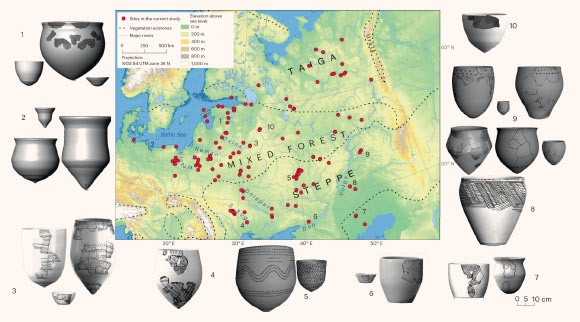Archaeologists have analyzed the remains of 1,226 pottery vessels from 156 hunter-gatherer sites across nine countries in Northern and Eastern Europe. Their findings suggest that pottery-making spread rapidly westwards from 5,900 BCE onwards and took only 300-400 years to advance over 3,000 km, equivalent to 250 km in a single generation.
Dolbunova et al. explored the behavioral mechanisms that led to the emergence of pottery among hunter-gatherer communities in Europe during the mid-Holocene; illustrated here are reconstructions from the (1) Eastern Baltic, (2) Western Baltic, (3) Upper Dnieper, (4) Bug-Dniester, (5) Middle Don, (6) Lower Don, (7) Northern Caspian, (8) Lower Volga, (9) Middle Volga and (10) Upper Volga regions. Image credit: Dolbunova et al., doi: 10.1038/s41562-022-01491-8.
Previous research has examined the spread of farming and associated technologies across Europe, but less is known of the hunter-gatherer societies that lived on the continent early in the Holocene period, from around 12,000 years ago.
These European societies relied on hunting, foraging and fishing for subsistence, and have left a relatively sparse archaeological record compared to early farming societies.
In their new research, Maynooth University’s Dr. Rowan McLaughlin and colleagues analyzed the remains of 1,226 pottery vessels from 156 hunter-gatherer sites across Northern and Eastern Europe.
They combined radiocarbon dating, together with data on the shape and decoration of ceramic vessels, and analyses of organic residues found inside the pots.
Their findings suggest that the spread of pottery occurred relatively rapidly westwards from 5900 BCE onwards and took only 300-400 years to advance over 3,000 km, or up to 250 km in a single generation.
Their analysis of the forms and decoration on the pottery suggests that it spread through a process of cultural transmission, and correlations between the properties of the pots and how they were used could be reflective of social traditions inherited by successive generations of hunter-gatherers.
“Our analysis of the ways pots were designed and decorated as well as new radiocarbon dates suggests that knowledge of pottery spread through a process of cultural transmission,” said University of York’s Professor Oliver Craig, co-senior author on the study.
“By this we mean that the activity spread by the exchange of ideas between groups of hunter-gatherers living nearby, rather than through migration of people or an expanding population as we see for other key changes in human history such as the introduction of agriculture.”
“That methods of pottery-making spread so far and so fast through the passing on of ideas is quite surprising.”
“Specific knowledge may have been shared through marriages or at centers of aggregation, specific points in the landscape where groups of hunter-gatherers came together perhaps at certain times of the year.”
Additionally, the researchers found evidence that the ceramics were used for cooking a wide range of foods, suggesting that pottery adoption was not driven by any specific economic or environmental pressures.
“We found evidence that the vessels were used for cooking a wide range of animals, fish and plants, and this variety suggests that the drivers for making the pottery were not in response to a particular need, such as detoxifying plants or processing fish, as has previously been suggested,” said British Museum’s Dr. Carl Heron, co-senior author on the study.
“We also found patterns suggesting that pottery use was transmitted along with knowledge of their manufacture and decoration.”
“These can be seen as culinary traditions that were rapidly transmitted with the artifacts themselves.”
The findings were published online today in the journal Nature Human Behaviour.
_____
E. Dolbunova et al. The transmission of pottery technology among prehistoric European hunter-gatherers. Nat Hum Behav, published online December 22, 2022; doi: 10.1038/s41562-022-01491-8




